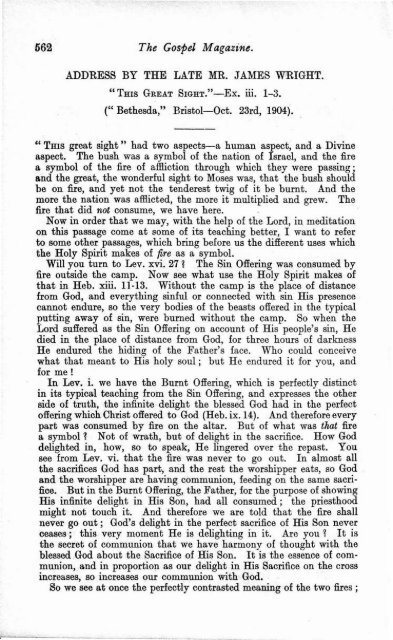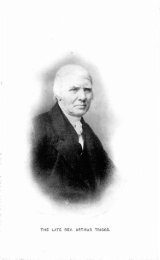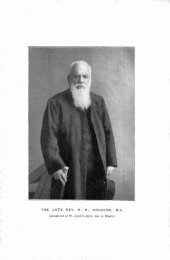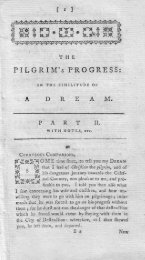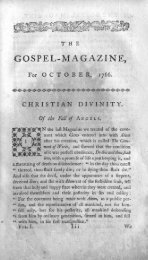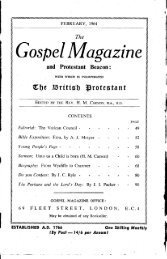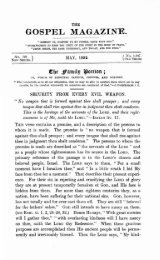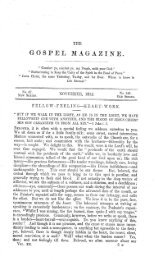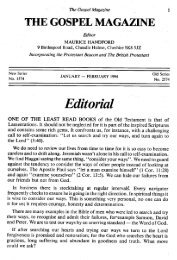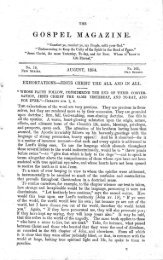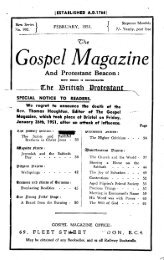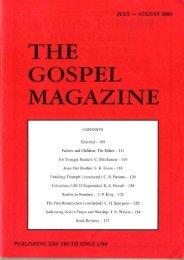THE REV. THOMAS CONNELLAN, - The Gospel Magazine
THE REV. THOMAS CONNELLAN, - The Gospel Magazine
THE REV. THOMAS CONNELLAN, - The Gospel Magazine
Create successful ePaper yourself
Turn your PDF publications into a flip-book with our unique Google optimized e-Paper software.
562 <strong>The</strong> <strong>Gospel</strong> <strong>Magazine</strong>.<br />
ADDRESS BY <strong>THE</strong> LATEMR. JAMES WRIGHT.<br />
"THIS GREAT SIGHT."-Ex. iii. 1-3.<br />
(" Bethesda," Bristol-Oct. 23rd, 1904).<br />
"THIS great sight" had two aspects-a human aspect, and a Divine<br />
aspect. <strong>The</strong> bush was a symbol of the nation of Israel, and the fire<br />
a symbol of the fire of affliction through which they were passing;<br />
and the great, the wonderful sight to Moses was, that the bush should<br />
be on fire, and yet not the tenderest twig of it be burnt. And the<br />
JIlore the nation was afflicted, the more it multiplied and grew. <strong>The</strong><br />
fire that did not consume, we have here.<br />
Now in order that we may, with the help of the Lord, in meditation<br />
on this passage come at some of its teaching better, I want to refer<br />
to some other passages, which bring before us the different uses which<br />
the Holy Spirit makes of fire as a symbol.<br />
. Will you turn to Lev. xvi. 27 ~ <strong>The</strong> Sin Offering was consumed by<br />
fire outside the camp. Now see what use the Holy Spirit makes of<br />
that in Heb. xiii. 11-13. Without the camp is the place of distance<br />
from God, and everything sinful or connected with sin His presence<br />
cannot endure, so the very bodies of the beasts offered in the typical<br />
putting away of sin, were burned without the camp. So when the<br />
Lord suffered as the Sin Offering on account of His people's sin, He<br />
died in the place of distance from God, for three hours of darkness<br />
He endured the hiding of the Father's face. Who could conceive<br />
what that meant to His holy soul; but He endured it for you, and<br />
for me!<br />
In Lev. i. we have the Burnt Offering, which is perfectly distinct<br />
in its typical teaching from the Sin Offering, and expresses the other<br />
side of truth, the infinite delight the blessed God had in the perfect<br />
offering which Christ offered to God (Heb. ix. 14). And therefore every<br />
part was consumed by fire on the altar. But of what was that fire<br />
a symbol ~ Not of wrath, but of delight in the sacrifice. How God<br />
delighted in, how, so to speak, He lingered over the repast. You<br />
see from Lev. vi. that the fire was never to go out. In almost all<br />
the sacrifices God has part, and the rest the worshipper eats, so God<br />
and the worshipper are having communion, feeding on the same sacrifice.<br />
But in the Burnt Offering, the Father, for the purpose of showing<br />
His infinite delight in His Son, had all consumed; the priesthood<br />
might not touch it. And therefore we are told that the fire shall<br />
never go out; God's delight in the perfect sacrifice of His Son never<br />
ceases; this very moment He is delighting in it. Are you ~ It is<br />
the secret of communion that we have harmony of thought with the<br />
blessed God about the Sacrifice of His Son. It is the essence of communion,<br />
and in proportion as our delight in His Sacrifice on the cross<br />
increases, so increases our communion with God. .<br />
So we see at once the perfectly contrasted meaning of the two fires;


